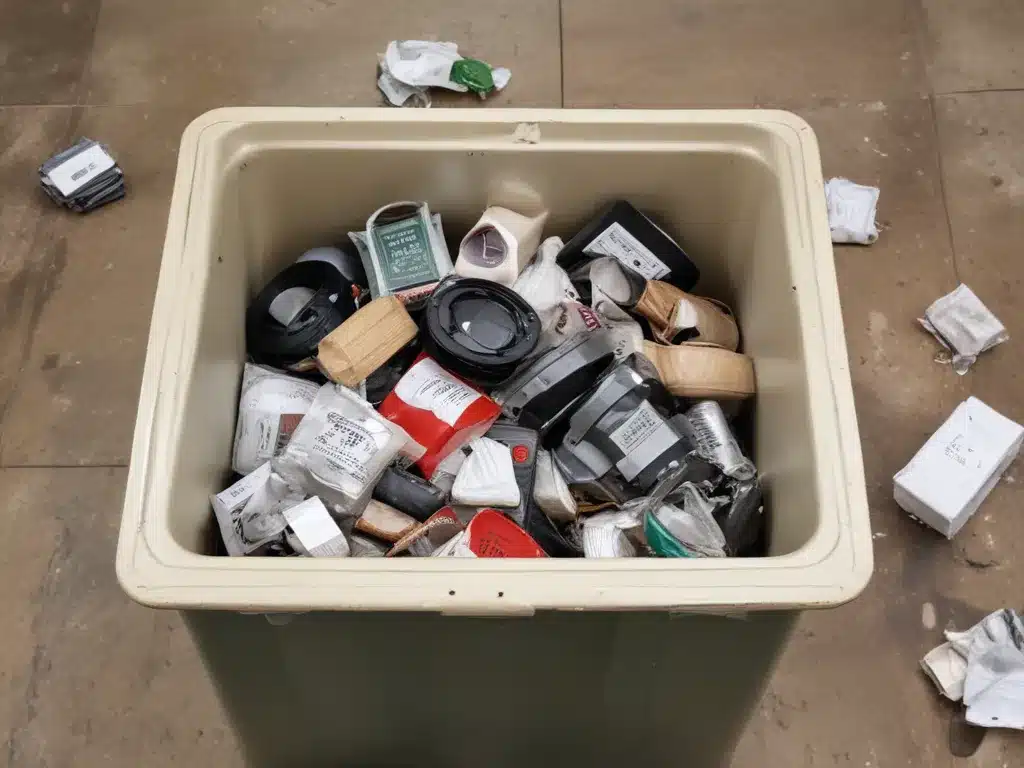Introduction
Every household accumulates items that eventually need to be discarded, whether it’s expired food, broken appliances, or hazardous materials. Proper disposal of these items is crucial for maintaining a safe and healthy environment. In this comprehensive guide, I will explore various aspects of safe item disposal, including the disposal of hazardous materials, recyclable items, and general household waste.
Hazardous Waste Disposal
Hazardous waste encompasses a wide range of materials that can pose a risk to human health and the environment if not handled and disposed of properly. These materials can be found in common household products such as cleaning supplies, paints, batteries, and electronics.
Types of Hazardous Waste
-
Chemical Waste: This category includes substances like household cleaners, paints, pesticides, and automotive fluids. These items often contain toxic chemicals that can contaminate soil and water sources.
-
Electronic Waste (e-waste): Electronics like computers, televisions, and cell phones contain various hazardous materials, including lead, mercury, and cadmium. Improper disposal of e-waste can lead to the release of these toxic substances into the environment.
-
Medical Waste: Households with individuals requiring at-home medical treatment may accumulate sharps (needles, syringes), soiled dressings, and other potentially infectious materials. These items must be handled with extreme caution to prevent the spread of disease.
Disposal Methods
-
Household Hazardous Waste Collection Events: Many communities organize periodic collection events where residents can safely dispose of hazardous waste items. These events are often advertised by local authorities and provide a convenient and responsible way to get rid of hazardous materials.
-
Hazardous Waste Disposal Facilities: Some areas have dedicated hazardous waste disposal facilities that accept various types of hazardous waste from households and businesses. These facilities are equipped to handle and process hazardous materials safely.
-
Mail-back Programs: For certain types of hazardous waste, such as compact fluorescent light bulbs (CFLs) and batteries, mail-back programs are available. These programs provide prepaid shipping containers or envelopes, allowing you to mail the hazardous items to a designated facility for proper disposal.
When disposing of hazardous waste, it is essential to follow all safety protocols, including wearing protective gear (gloves, goggles, etc.), properly labeling and sealing containers, and avoiding mixing incompatible materials.
Recyclable Item Disposal
Recycling is an essential practice that helps reduce waste and conserve natural resources. Many common household items can be recycled, including paper, plastics, glass, and metals.
Recycling Guidelines
-
Paper and Cardboard: Clean and dry paper products, including newspapers, magazines, office paper, and cardboard boxes, are typically accepted for recycling.
-
Plastics: Many municipalities have specific guidelines for plastic recycling, often accepting common plastic containers such as water bottles, milk jugs, and detergent bottles. Check the recycling symbols and numbers on the items to ensure they are accepted in your local recycling program.
-
Glass: Glass bottles and jars are widely accepted for recycling, but it’s essential to remove lids, caps, and any non-glass components before placing them in the recycling bin.
-
Metals: Aluminum cans, steel cans, and other metal items are commonly recycled. Ensure they are rinsed clean and free of food residue before recycling.
Proper Preparation
To ensure efficient recycling, follow these preparation guidelines:
- Rinsing: Rinse out any food or liquid residue from containers to prevent contamination and odors.
- Sorting: Sort recyclable items according to your local recycling program’s guidelines, typically by material type (paper, plastic, glass, metal).
- Flattening or Breaking Down: Flatten cardboard boxes and break down larger items to save space in the recycling bin.
- Removing Non-Recyclable Components: Remove and dispose of non-recyclable components like plastic lids, caps, or labels separately.
By properly sorting and preparing recyclable items, you can ensure they are processed efficiently and contribute to a more sustainable environment.
General Household Waste Disposal
Not all household items are hazardous or recyclable, leaving a significant amount of general waste that needs to be properly disposed of.
Responsible Waste Management
-
Proper Bagging: Use sturdy plastic bags or bins to contain household waste, ensuring they are securely tied or closed to prevent spills or odors.
-
Separating Waste Types: Separate different types of waste, such as food waste, yard waste, and general household waste, as per your local waste management guidelines.
-
Composting: Consider composting organic waste like food scraps and yard trimmings to reduce the amount of waste sent to landfills and create nutrient-rich soil for gardening.
-
Donating or Repurposing: Before discarding items, consider donating or repurposing them if they are still in good condition. Many charities and organizations accept gently used items, and repurposing items can extend their lifespan and reduce waste.
Special Disposal Considerations
Certain household items may require special disposal considerations:
-
Bulky Items: Large items like furniture, appliances, or mattresses may need to be disposed of through special pick-up services or designated drop-off locations.
-
Biohazardous Waste: If you need biohazard cleaning, it’s crucial to follow proper protocols for handling and disposing of potentially infectious materials. Consider hiring a professional biohazard cleaning service like AdamCleaning.uk for safe and effective biohazard waste disposal.
-
Construction or Demolition Debris: Waste generated from home renovations or demolition projects may require separate disposal arrangements, such as renting a dumpster or utilizing specialized disposal facilities.
By responsibly managing general household waste and adhering to local guidelines, you can contribute to a cleaner and more sustainable environment.
Conclusion
Safe item disposal is a critical aspect of maintaining a healthy and environmentally conscious household. By understanding the proper disposal methods for hazardous waste, recyclable items, and general household waste, you can play an active role in protecting the environment and promoting sustainable practices. Remember, responsible disposal not only ensures a safer living space but also contributes to a better world for future generations.







